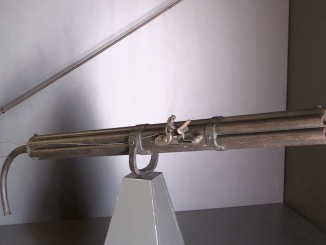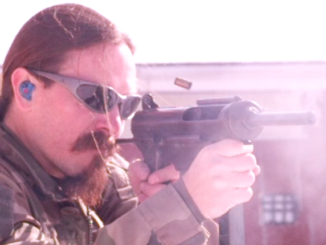When Melvin Johnson’s rifle design was first going through US military testing in 1938, it was set up to use box magazines. These magazines were a problem – they were not quite fully perfected, and were causing a lot of the problem that the rifle was having. Johnson opted to withdraw the rifle from trials, and revise the design to use a 10-round rotary magazine instead.
This took place after his relationship with the Marlin company had ended, and a machine shop called Taft-Peirce had signed a contract to make rifles for Johnson. They designated the new rotary magazine type of rifle the Model R, and made seven military pattern examples for further trials (as well as seven sporting pattern guns). the military model had a bayonet lug for a Krag/Springfield standard bayonet, and a wooden handguard on the exposed front section of the barrel.
Thanks to the Cody Firearms Museum for allowing me access to film this prototype rifle!




Ian… That is not a sling swivel there nearest the muzzle. That is a stacking hook…
Do you mean like the BSA badge, three “stacked” guns… Boers etc, bugle.
Type thing, reckon you do.
Zulus… ZULU!!! Great them.
You’re both half right. The contraption that looks like a sling swivel with a chunk taken out of the middle is called a ‘stacking swivel.’
Seems strange that Johnson would not use the in production 8shot clip?
In one of the books or articles about Johnson I’ve read, he’s asked specifically why this was, and why he put a single-stack magazine on the Johnson LMG. He responded with a litany about double-feed magazines like the BAR’s, and the Mannlicher-style clips as being too prone to damage. He saw the magazine feed lips as being the biggest problem with any feed system, and he wanted them to be permanently built into the weapon, made of machined steel. As well, he discussed the superiority of the rotary magazine because you could top it off whenever you needed to, as opposed to having to wait until you were out of ammo with the Garand.
He had his reasons, and they were based on his experience with pre-1930s stamped sheet metal assemblies. The early BAR magazines were, shall we say… Problematic?
Interesting to know. Drum and Pan magazines persisted, but were going away during and after WW2. I suppose at the time Johnson began design it made sense.
I would have thought the “top up” feature died with the Krag. The 1911 and Thompson stick magazines were fine I thought.
The Rotary was in the Greek Mannlicher? or some such and highly regarded, just not justified in a military arm.
I have read contradictory reports supposedly going back to Guadalcanal use of Johnson Rifles and Machine Guns.
Ruger uses the rotary magazine, not sure of anyone else now?
What stands out is every designer has preferences and priorities.
I suppose it is like wood going out of use.
Not sure of preference over M1 or BAR. Back then.
And early M1918 batches were plagued with receivers that would not accept magazines except for the ones paired with each individual gun. Whoever did that job was an idiot!
I do not know if it contain response to your question, but there is available
THE JOHNSON SEMIAUTOMATIC RIFLE
HEARING
BEFORE
COMMITTEE ON MILITARY AFFAIRS
UNITED STATES SENATE
SEVENTY-SIXTH CONGRESS
THIRD SESSION
ON
S. 3983
A BILL TO PROVIDE FOR THE ADOPTION OF THE
JOHNSON SEMIAUTOMATIC RIFLE AS A
STANDARD ARM OF THE MILITARY
AND NAVAL FORCES
MAY 29, 1940
https://www.forgottenweapons.com/johnson-semiauto-rifle-senate-hearing/
with many question and responses to them.
The Johnson Auto Carbine next please.
That front swivel is, I’m pretty sure, a stacking swivel, more than a sling swivel.
Not sure that anyone was still requiring that, but given the usual Ordnance Corp silliness…maybe?
ZULU!!
Every M1 Garand delivered to the War Department had a stacking swivel. It’s the “split” swivel at the very front end of the wooden forestock.
As to its practical utility, ask any veteran of the Pacific or Italian campaign, or any from Korea, how useful hooking three M1s together in a tripod was in keeping them up out of the mud.
In Vietnam, one of the complaints about both the M14 and the M16 was that they had no stacking swivels. In a country pretty much composed of mud.
cheers
eon
I have seen picture of M16 “stacked” in the mud in Vietnam. It was using bayonet, poked in it upside down. GIs are inventive when comes to it.
I see the Johnson rifle as a smart design, but well ahead of its time and that may have been a problem for its acceptance. That overhanging long barrel did not bode well with trend of the time, for use of bayonet in particular. I wonder how would it look if reformulated for use of current caliber(s). The built-in magazine is also a feat of engineering although it makes it look like ‘pregnant beluga’.
The very last generation of 6.8mm rifles (General Dynamics model) has recoiling barrel although it is connected with ‘receiver’ inside of outer envelope. There is no free hanging barrel on the outside so no one can even tell.
To set up M16’s in a tripod without stacking swivels, adjust the sling on the number 1 rifle with a small loop near the handguard. Insert the barrels of the #2 and #3 rifles in opposite sides of this loop, then swing their butts down to the ground. You now have a stack of three rifles that other rifles can be leaned against. (Basic training, Ft Jackson, 1972)
Photo of soldiers of the Royal Netherlands East Indies Army in July 1945, all the ones on the right side appear to have Johnson’s:
https://upload.wikimedia.org/wikipedia/commons/a/ad/KNIL._Een_oefening_met_machingeweren_in_een_opleidingskamp_op_Nieuw-Guinea%2C_Bestanddeelnr_29013_013.jpg
The Johnson was an interesting rifle, but very overrated. It was complicated to manufacture and to keep up in the field. When you read the pro Johnson people one thinks the Garand was junk. To many parts a recip barrel and if it got muddy it stopped working. Still, an interesting concept.
Certainly the “para-marines” and other USMC units got them–along with Reising SMGs–at a time when the marines were still using the water-cooled M1917 Browning MG and the 1903 Springfield manually-operated bolt-action rifle. The barrel could be detached and separated from the stock and receiver, which were certainly handy features for storage or clandestine use.
The Johnson–like the unsuccessful rifles of Søren Hansen Bang–used a light-weight barrel, so as it heated up from shooting full-house .30-06 M2 ball cartridges, there was a tendency for the shots to begin “stringing” vertically.
The bayonet thing… Good grief! Thankfully by 1943 I think the K-bar knife was pretty much standard issue, yes?
Having thoughtlessly touched an FAL barrel after firing 40 rounds, I can see why they wanted a handguard.
When WW2 started anything that would send a bullet down range was used. As soon as enough Garands were in the pipe line everything else was replaced. The Johnson had problems shooting the most commonly issued ammunition of WW2 M2 AP which was 165 to 168 gr at about 2750fps. Garands were designed around this and M1 ball 172 grs at 2750 fps. The Johnson would string after one mag and have to cool while the Springfield and Garand didn’t. Interesting rifle, but not in the realm of the Garand. M2 Ball was a light target load for the 500 yrd ranges of the National Guard developed in the late 20’s. It was never intended as a general issue load.